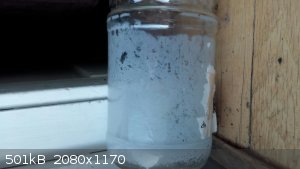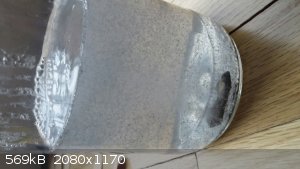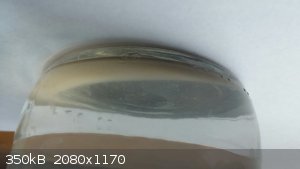AJKOER
Radically Dubious
    
Posts: 3026
Registered: 7-5-2011
Member Is Offline
Mood: No Mood
|
|
Strong NaOH (or KOH) from Ag2O and NaCl (KCl) ?
I have been experimenting with Silver salts recently, and I believe I have accidentally demonstrated that one can create a strong base from Ag2O!
Per Wikipedia (http://en.m.wikipedia.org/wiki/Silver_hydroxide#Preparation ):
"It will also react with solutions of alkali chlorides to precipitate silver chloride, leaving a solution of the corresponding alkali
hydroxide.[12][11]"
I prepared some Ag2O, which left in the presence of NaCl and some water, then appears to have reacted as follows:
Ag2O + H2O + 2 NaCl --) 2 NaOH + 2 AgCl (s)
Interestingly, as one can recycle the Silver chloride, it appears that one can create a large amount (by recycling the Silver chloride) of NaOH (or
KOH..) from the likes of inexpensive NaCl (KCl..).
Cool!
The attached picture shows one etched storage jar (I would not recommend repeating this experiment with your expensive glassware!).

[Edited on 4-4-2015 by AJKOER]
|
|
|
AJKOER
Radically Dubious
    
Posts: 3026
Registered: 7-5-2011
Member Is Offline
Mood: No Mood
|
|
Excuse the mis-post, I am using a nook and somehow, while trying to edit, it just posted!
|
|
|
aga
Forum Drunkard
    
Posts: 7030
Registered: 25-3-2014
Member Is Offline
|
|
Shit happens, especially with technological artefacts.
Do you think you can work this up to a repeatable process ?
|
|
|
gdflp
Super Moderator
      
Posts: 1320
Registered: 14-2-2014
Location: NY, USA
Member Is Offline
Mood: Staring at code
|
|
How are you preparing the silver oxide without hydroxides? This is an interesting idea, the only problem that arises is that which nearly production
methods of hydroxides face(I believe), drying the hydroxides to produce solid material.
|
|
|
AJKOER
Radically Dubious
    
Posts: 3026
Registered: 7-5-2011
Member Is Offline
Mood: No Mood
|
|
Quote: Originally posted by aga  | Shit happens, especially with technological artefacts.
Do you think you can work this up to a repeatable process ? |
A cool way (as one would be using a very accessible weak base to create a strong one) to repeat would be to use dilute ammonia water (not in excess)
acting on say Silver acetate. Wash the precipitate to remove any ammonium acetate and add a moist chloride of your choice  . .
------------------------
Interestingly, one can fairly quickly prepare Silver acetate in limited quantities (in a few hours) by adding Silver metal to dilute H2O2, vinegar and
some KNO3 to serve as an electrolyte (and not my normal recommendation of sea salt, as a chloride will not work here) for the electrochemical cell. I
briefly heated in a microwave to jump start the reaction, and added more H2O2 and/or vinegar as needed to keep it going. The picture below was
actually taken within the 1st hour and shows, contrary to normal practice and the needless use of HNO3, one can prepare (cheaply and safely) a Silver
salt from the metal in a matter of hours.

[Edit] Since KNO3 is employed here, I should mention that it is not a completely passive electrolyte. In fact, with light, both H2O2 and KNO3 can form
hydroxyl radicals as I have detailed previously (see, for example, http://www.sciencemadness.org/talk/viewthread.php?tid=34429#... ). So with time, the solution forms a black precipitate as the acetate ion is
attacked and eventually, in the presence of H2O2 also, I suspect leads to the formation of the black Ag2O. On further boiling with Na2CO3, a clear
solution (containing aqueous NaOH) develops with a tan precipitate of Ag2CO3 (see attached picture).

[Edited on 5-4-2015 by AJKOER]
|
|
|